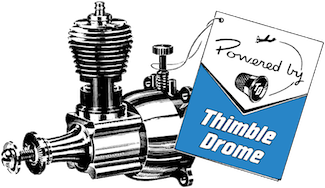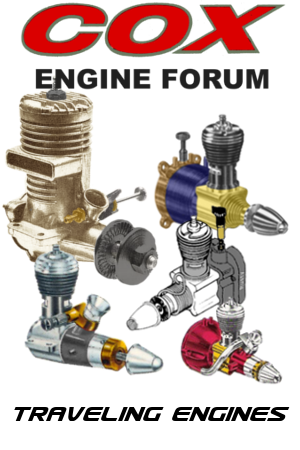Log in
Search
Latest topics
» WenMac 049 - Glow Plug & Head Gasket replacements?by Ken Cook Today at 3:17 pm
» audio-tach anyone?
by roddie Today at 2:58 pm
» A choke-tube with velocity-stack configured Bee
by roddie Today at 2:54 pm
» Jim Walkers FireBee - This is going to be fun
by rsv1cox Today at 2:43 pm
» 12 string guitar suggestions
by 1/2A Nut Today at 1:58 pm
» Nostalgia alert, my 1959 Corvette revisited
by Admin Today at 1:11 pm
» Hawk had breakfast and then took a bath
by rsv1cox Today at 10:26 am
» Prop Rod - resto to a runner
by rsv1cox Today at 7:32 am
» Jim Walker Firebaby
by rdw777 Yesterday at 4:58 pm
» Prayers for my Wife Please
by akjgardner Yesterday at 10:28 am
» Cox prop rod
by Wiggy Fri May 17, 2024 4:30 pm
» "Red Neck" .049 elec. starter
by getback Fri May 17, 2024 7:19 am
What are the symptoms of a leaking venturi o-ring?
Page 1 of 1
 What are the symptoms of a leaking venturi o-ring?
What are the symptoms of a leaking venturi o-ring?
I am curious because when the fuel tank is full or 1/2 full,
a vacuum leak on the venturi tube would suck fuel into the
venturi tube and cause the engine to run rich.
As the fuel tank level is below half tank, a vacuum leak on
the venturi tube would suck air into the venturi tube and
cause the engine to run lean.
If the fuel tank is full and running lean, the air leak is on the
crankcase paper gasket or the nose of the crankcase because
of friction or excessive wear?
Bill M.
a vacuum leak on the venturi tube would suck fuel into the
venturi tube and cause the engine to run rich.
As the fuel tank level is below half tank, a vacuum leak on
the venturi tube would suck air into the venturi tube and
cause the engine to run lean.
If the fuel tank is full and running lean, the air leak is on the
crankcase paper gasket or the nose of the crankcase because
of friction or excessive wear?
Bill M.

wmazz- Bronze Member

- Posts : 40
Join date : 2018-12-31
Location : Riverside CA.
 symptoms of o-ring air leak.
symptoms of o-ring air leak.
When the venturi to tank O-ring leaks, generally the engine will only run out the prime & quit. No amount of richening the needle will help.
Now, if the tank leaks from any one of the 4 tank holes, or from any area on the tank to backplate periphery, or from the crankcase gasket
area, then you can incur any number of unstable running characteristics from rich to lean to in between...
I'm not sure all why leaks develop, but will say the MOST COMMON is because the 4 tank screws tend to come loose.
Good luck.
Cheers, Paul
----------------------------------------------------------------------------
I am curious because when the fuel tank is full or 1/2 full,
a vacuum leak on the venturi tube would suck fuel into the
venturi tube and cause the engine to run rich.
As the fuel tank level is below half tank, a vacuum leak on
the venturi tube would suck air into the venturi tube and
cause the engine to run lean.
If the fuel tank is full and running lean, the air leak is on the
crankcase paper gasket or the nose of the crankcase because
of friction or excessive wear?
Now, if the tank leaks from any one of the 4 tank holes, or from any area on the tank to backplate periphery, or from the crankcase gasket
area, then you can incur any number of unstable running characteristics from rich to lean to in between...
I'm not sure all why leaks develop, but will say the MOST COMMON is because the 4 tank screws tend to come loose.
Good luck.
Cheers, Paul
----------------------------------------------------------------------------
I am curious because when the fuel tank is full or 1/2 full,
a vacuum leak on the venturi tube would suck fuel into the
venturi tube and cause the engine to run rich.
As the fuel tank level is below half tank, a vacuum leak on
the venturi tube would suck air into the venturi tube and
cause the engine to run lean.
If the fuel tank is full and running lean, the air leak is on the
crankcase paper gasket or the nose of the crankcase because
of friction or excessive wear?

Paulgibeault- Gold Member

- Posts : 259
Join date : 2011-09-24
Location : Leduc, Alberta Canada
 Re: What are the symptoms of a leaking venturi o-ring?
Re: What are the symptoms of a leaking venturi o-ring?
Thank you for responding, and for writing an excellent paper on reed
valved engines
When I first started using Cox engines as a teen, and later as an adult
running out the prime and quitting was common place. I was a watercraft
mechanic, and vacuum leaks were the most common (misunderstood)
problem that plagued all of the brands. Watercraft, despite the size difference
experience similar problems to glow engines because of the diaphragm carbs.
A diaphragm carb is affect by vacuum leaks as far away as on the crankshaft,
and float bowl carbs barely notice the same problem.
So I like chasing vacuum leaks. back in the early 90's I fixed the problem
a different way. So I was curious if I overlooked the venturi tube o-ring,
or did people fix their engines by simply disassembling their engine and
accidentally repair the the problem during reassembly.
I have found most people working on their own watercraft only pay attention
to the reassembly and not the disassembly.
That is a decent method, but I am curious if you learned the hard way that loctite
can fill the bottom of the screw hole, and after a few uses of loctite, the bottom of
the hole is filled with loctite. Then the tank screws bottom out against the loctite
deposit and actually prevent the screws from tightening the tank?
Have you ever used ultra silicone, 3bond 1107B, 1211, or loctite 515 on the side
of the tank screw? When I assemble engines I prefer to use these products as a
replacement for loctite. Have you ever used any of these products?
Do tank screws leak fuel if they are tight?
Thanks
Bill M.
I will be using much of this info next week on a pee wee rebuild
valved engines
Paulgibeault wrote:generally the engine will only run out the prime & quit. No amount of richening the needle will help.
When I first started using Cox engines as a teen, and later as an adult
running out the prime and quitting was common place. I was a watercraft
mechanic, and vacuum leaks were the most common (misunderstood)
problem that plagued all of the brands. Watercraft, despite the size difference
experience similar problems to glow engines because of the diaphragm carbs.
A diaphragm carb is affect by vacuum leaks as far away as on the crankshaft,
and float bowl carbs barely notice the same problem.
So I like chasing vacuum leaks. back in the early 90's I fixed the problem
a different way. So I was curious if I overlooked the venturi tube o-ring,
or did people fix their engines by simply disassembling their engine and
accidentally repair the the problem during reassembly.
I have found most people working on their own watercraft only pay attention
to the reassembly and not the disassembly.
Does that happen because people over tighten the tank screws??Paulgibeault wrote:
but will say the MOST COMMON is because the 4 tank screws tend to come loose.
Paulgibeault wrote:
In your paper, you wrote "After final assembly, the tank screw hole areas are filled
with RTV silicone sealant for leak prevention."
That is a decent method, but I am curious if you learned the hard way that loctite
can fill the bottom of the screw hole, and after a few uses of loctite, the bottom of
the hole is filled with loctite. Then the tank screws bottom out against the loctite
deposit and actually prevent the screws from tightening the tank?
Have you ever used ultra silicone, 3bond 1107B, 1211, or loctite 515 on the side
of the tank screw? When I assemble engines I prefer to use these products as a
replacement for loctite. Have you ever used any of these products?
Do tank screws leak fuel if they are tight?
Thanks
Bill M.
I will be using much of this info next week on a pee wee rebuild

wmazz- Bronze Member

- Posts : 40
Join date : 2018-12-31
Location : Riverside CA.
 Re: What are the symptoms of a leaking venturi o-ring?
Re: What are the symptoms of a leaking venturi o-ring?
Bill, tank screws leak. If your interested in determining venturi leaks, it's quite simple. Turn the needle all the way in and bottom it out. Using a syringe and a long piece of fuel tubing that fits the fuel filler nipple inflate the tank. I use large 5 oz syringes to do this. You will discover a multitude of leaks. If the o-ring is bad or not sealing properly, you will distinctively hear air escaping from the venturi. You will then discover that the v-groove tank to tank back seal is leaking. If it's not leaking put some oil on the tank perimeter and oil on the screw heads and re inflate. Put oil on the top of the backplate where the needle exits and you will find the threads leaking air around them and possibly the insert that's pressed into the tank back. Put oil around the crankcase to tank and you will possibly see bubbles coming from there as well. All of these potentially compromise engine run and duration of run.
Sanding the back of the case on a piece of glass using 400 trues up this surface and remedies leaking with a new gasket usually.
Tank to tank back is a bit more problematic. I have used dental floss in the v-groove using one continuous piece which overlaps about 1/2". This will be the most fun you ever had placing that in the groove. It goes 3/4 around and lays in perfect and then it sticks to your fingers and accidentally comes out, then it begins to fray. It's a real joy. A little oil here helps it stick and lay down better.
I don't use sealers of any kind on the screws, If I find certain screws are leaking, I replace them with new ones which a good percentage of the time stops this. If it doesn't stop the leak, I found tearing a Q-tip head off and pulling off about 1" strip about 1/8" wide. Roll it up and wrap it on the underside of the head of the screw in the direction that it will tighten against the screw body during assembly. In other words, use the cotton in the same fashion as you would apply Teflon tape. I found this to be the most effective way for me to seal and be able to unscrew and reseal in minutes if the need was to arise.
Needle valves can be sealed using the correct size tubing properly cut. When I cut tubing, I push it onto a piece of 1/8" music wire and I chuck it up in the drill press. I then use a single edged razor blade to cut the tubing as it's spinning with a new razor blade. This offers clean square cuts and I can make multiple sizes doing so. I just place a washer under the flange of the needle valve and the tubing under that.
Sanding the back of the case on a piece of glass using 400 trues up this surface and remedies leaking with a new gasket usually.
Tank to tank back is a bit more problematic. I have used dental floss in the v-groove using one continuous piece which overlaps about 1/2". This will be the most fun you ever had placing that in the groove. It goes 3/4 around and lays in perfect and then it sticks to your fingers and accidentally comes out, then it begins to fray. It's a real joy. A little oil here helps it stick and lay down better.
I don't use sealers of any kind on the screws, If I find certain screws are leaking, I replace them with new ones which a good percentage of the time stops this. If it doesn't stop the leak, I found tearing a Q-tip head off and pulling off about 1" strip about 1/8" wide. Roll it up and wrap it on the underside of the head of the screw in the direction that it will tighten against the screw body during assembly. In other words, use the cotton in the same fashion as you would apply Teflon tape. I found this to be the most effective way for me to seal and be able to unscrew and reseal in minutes if the need was to arise.
Needle valves can be sealed using the correct size tubing properly cut. When I cut tubing, I push it onto a piece of 1/8" music wire and I chuck it up in the drill press. I then use a single edged razor blade to cut the tubing as it's spinning with a new razor blade. This offers clean square cuts and I can make multiple sizes doing so. I just place a washer under the flange of the needle valve and the tubing under that.

Ken Cook- Top Poster

- Posts : 5491
Join date : 2012-03-27
Location : pennsylvania
 Leaking Venturi O-ring etc.
Leaking Venturi O-ring etc.
Bill,
Thank you for the kind words. Ken has posted some excellent notes on the subject.
You ask why the Cox reed valve tanks come loose. Such an excellent question as I still don't have a really good handle on this situation.
Some fixes that have been tried are Loc-tite, but this doesn't always seem to work. Although it's conceivable to bottom out the screws on old Loctite ,
I don't think my screws are bottoming out in a Loctite filled hole because I bottom tap the holes prior to remove any residual.
What I feel is the REAL PROBLEM is the metal (& nylon) backplate materials are just TOO SOFT.
On some soft backplates even "reasonable" torque on the screws can warp & even tear out the pot metal from the backplate.
It appears to me to be hit and miss as to which Cox backplates are overly soft.
Some permanent fixes involved:
1. Making a new tank backplate & NVA out of steel = permanent end of problem & a better NVA can be used.
2. Dispensing of the screws & replacing with longer 2-56 TPI studs. The assembly is then held together with proper lock nuts that can be really tightened down
on the backplate using large washers to distribute the load. This however needs a lot of relief on the firewall to accommodate the nuts & washers.
3. J-B Welding a 1/16" or thicker aluminum plate directly onto the pot metal backplate. This will require longer tank attach screws, but the result will be
similar to Item 2, in that you now have a much stronger & more stable backplate, allowing increased torque on the screws.
Your suggestion to use different adhesive materials has much merit as even to date I still have engines coming loose when I don't want then to.
Very annoying to me as that condition ends up takes the engine out of service until it's removed reassembled & re-installed.
Last question: YES fuel tank screws will still leak (varying amounts) where they go through the backplate. Some people have tried using small o-rings there.
As you know I use RTV silicone to do the same thing. I had hoped that the silicone would also work as a kind of a "lock washer" for the screw but relatively high
RPM mouse racing has shown my engine tanks can still come loose regardless.
Truly Items 1. & 2. have yielded better results, but I'm still forever hopeful there is an easier, simpler & cheaper way to solve this problem... I just haven't found it yet!
Good luck on your Pee Wee re-build!
Cheers, Paul
Thank you for the kind words. Ken has posted some excellent notes on the subject.
You ask why the Cox reed valve tanks come loose. Such an excellent question as I still don't have a really good handle on this situation.
Some fixes that have been tried are Loc-tite, but this doesn't always seem to work. Although it's conceivable to bottom out the screws on old Loctite ,
I don't think my screws are bottoming out in a Loctite filled hole because I bottom tap the holes prior to remove any residual.
What I feel is the REAL PROBLEM is the metal (& nylon) backplate materials are just TOO SOFT.
On some soft backplates even "reasonable" torque on the screws can warp & even tear out the pot metal from the backplate.
It appears to me to be hit and miss as to which Cox backplates are overly soft.
Some permanent fixes involved:
1. Making a new tank backplate & NVA out of steel = permanent end of problem & a better NVA can be used.
2. Dispensing of the screws & replacing with longer 2-56 TPI studs. The assembly is then held together with proper lock nuts that can be really tightened down
on the backplate using large washers to distribute the load. This however needs a lot of relief on the firewall to accommodate the nuts & washers.
3. J-B Welding a 1/16" or thicker aluminum plate directly onto the pot metal backplate. This will require longer tank attach screws, but the result will be
similar to Item 2, in that you now have a much stronger & more stable backplate, allowing increased torque on the screws.
Your suggestion to use different adhesive materials has much merit as even to date I still have engines coming loose when I don't want then to.
Very annoying to me as that condition ends up takes the engine out of service until it's removed reassembled & re-installed.
Last question: YES fuel tank screws will still leak (varying amounts) where they go through the backplate. Some people have tried using small o-rings there.
As you know I use RTV silicone to do the same thing. I had hoped that the silicone would also work as a kind of a "lock washer" for the screw but relatively high
RPM mouse racing has shown my engine tanks can still come loose regardless.
Truly Items 1. & 2. have yielded better results, but I'm still forever hopeful there is an easier, simpler & cheaper way to solve this problem... I just haven't found it yet!
Good luck on your Pee Wee re-build!
Cheers, Paul
wmazz wrote:Thank you for responding, and for writing an excellent paper on reed
valved engines Paulgibeault wrote:generally the engine will only run out the prime & quit. No amount of richening the needle will help.
Paulgibeault wrote:generally the engine will only run out the prime & quit. No amount of richening the needle will help.
So I like chasing vacuum leaks. back in the early 90's I fixed the problem
a different way. So I was curious if I overlooked the venturi tube o-ring,
or did people fix their engines by simply disassembling their engine and
accidentally repair the the problem during reassembly.Does that happen because people over tighten the tank screws??Paulgibeault wrote:
but will say the MOST COMMON is because the 4 tank screws tend to come loose.Paulgibeault wrote:
In your paper, you wrote "After final assembly, the tank screw hole areas are filled
with RTV silicone sealant for leak prevention."
That is a decent method, but I am curious if you learned the hard way that loctite
can fill the bottom of the screw hole, and after a few uses of loctite, the bottom of
the hole is filled with loctite. Then the tank screws bottom out against the loctite
deposit and actually prevent the screws from tightening the tank?
Have you ever used ultra silicone, 3bond 1107B, 1211, or loctite 515 on the side
of the tank screw? When I assemble engines I prefer to use these products as a
replacement for loctite. Have you ever used any of these products?
Do tank screws leak fuel if they are tight?
Thanks
Bill M.

Paulgibeault- Gold Member

- Posts : 259
Join date : 2011-09-24
Location : Leduc, Alberta Canada
 Re: What are the symptoms of a leaking venturi o-ring?
Re: What are the symptoms of a leaking venturi o-ring?
Paulgibeault wrote:
Your suggestion to use different adhesive materials has much merit as even to date I still have engines coming loose when I don't want then to.
Very annoying to me as that condition ends up takes the engine out of service until it's removed reassembled & re-installed.
Paulgibeault wrote:
Last question: YES fuel tank screws will still leak (varying amounts) where they go through the backplate.
Try the 3bond 1107b (Suzuki Bond), or Ultra Silicone. They are both oil
proof. Except 1107b is +20$ U.S.
Paulgibeault wrote:
but relatively high RPM mouse racing has shown my engine tanks can still come loose regardless.
Sounds like the same old problem with single cylinder crank balance. An
.049 opposed twin would fix that
Thanks Again!
Bill M.

wmazz- Bronze Member

- Posts : 40
Join date : 2018-12-31
Location : Riverside CA.
 Re: What are the symptoms of a leaking venturi o-ring?
Re: What are the symptoms of a leaking venturi o-ring?
Ken I am sorry, I didn't see your post until after I read Paulgibeault's posts 
Sounds like I will need to skip sealing the tank, I shake too much.
I would have never thought to use cotton to seal a leak.
Bill M.
Thanks Ken, The pressure test is a great idea!Ken Cook wrote: Bill, tank screws leak. If your interested in determining venturi leaks, it's quite simple. Turn the needle all the way in and bottom it out. Using a syringe and a long piece of fuel tubing that fits the fuel filler nipple inflate the tank. I use large 5 oz syringes to do this. You will discover a multitude of leaks. If the o-ring is bad or not sealing properly, you will distinctively hear air escaping from the venturi. You will then discover that the v-groove tank to tank back seal is leaking. If it's not leaking put some oil on the tank perimeter and oil on the screw heads and re inflate. Put oil on the top of the backplate where the needle exits and you will find the threads leaking air around them and possibly the insert that's pressed into the tank back. Put oil around the crankcase to tank and you will possibly see bubbles coming from there as well. All of these potentially compromise engine run and duration of run.
That is how I use to fix vacuum leaks.Ken Cook wrote:
Sanding the back of the case on a piece of glass using 400 trues up this surface and remedies leaking with a new gasket usually.
Ken Cook wrote:
Tank to tank back is a bit more problematic. I have used dental floss in the v-groove using one continuous piece which overlaps about 1/2". This will be the most fun you ever had placing that in the groove. It goes 3/4 around and lays in perfect and then it sticks to your fingers and accidentally comes out, then it begins to fray. It's a real joy. A little oil here helps it stick and lay down better.
Sounds like I will need to skip sealing the tank, I shake too much.
Ken Cook wrote:
I don't use sealers of any kind on the screws, If I find certain screws are leaking, I replace them with new ones which a good percentage of the time stops this. If it doesn't stop the leak, I found tearing a Q-tip head off and pulling off about 1" strip about 1/8" wide. Roll it up and wrap it on the underside of the head of the screw in the direction that it will tighten against the screw body during assembly. In other words, use the cotton in the same fashion as you would apply Teflon tape. I found this to be the most effective way for me to seal and be able to unscrew and reseal in minutes if the need was to arise.
I would have never thought to use cotton to seal a leak.
Bill M.

wmazz- Bronze Member

- Posts : 40
Join date : 2018-12-31
Location : Riverside CA.
 Re: What are the symptoms of a leaking venturi o-ring?
Re: What are the symptoms of a leaking venturi o-ring?
Bill in case you missed the hints:
Ken suggested lapping the back of the crank case ..WHY Cox macheining left all 4 screw holes with a raised lip from the tapping...600, 800, or higher grit a little oil and it takes less than one minuet in a figure eight pattern with moderate pressure to make the CC flat again
Paul and others suggest Bottom Tapping the 4 crank case holes ...2-56 bottom tap..dubro is no bottom tap but nose can be ground flat to be one...Why..Cox drilled holes nearly to the front of the case...BUT they only tapped about 3/4 % in to the cavity/hole.... not all Cox back plat screws are equal length and many bottom out before being tight on the back plate
Run a Tap n oil in and cut two or three more threads...takes about one minuet...
I use Permetex Anerobic Gasket maker when assembling my Cox small engines
I also use just a toothpick tip worth of Thread locker in each of the 4 tank back screw holes...literally just a micro smidgen tiny tad of blue helps keep the vibration loosening from occurring and not enough to make disassembly impossible
Ken suggested lapping the back of the crank case ..WHY Cox macheining left all 4 screw holes with a raised lip from the tapping...600, 800, or higher grit a little oil and it takes less than one minuet in a figure eight pattern with moderate pressure to make the CC flat again
Paul and others suggest Bottom Tapping the 4 crank case holes ...2-56 bottom tap..dubro is no bottom tap but nose can be ground flat to be one...Why..Cox drilled holes nearly to the front of the case...BUT they only tapped about 3/4 % in to the cavity/hole.... not all Cox back plat screws are equal length and many bottom out before being tight on the back plate
Run a Tap n oil in and cut two or three more threads...takes about one minuet...
I use Permetex Anerobic Gasket maker when assembling my Cox small engines
I also use just a toothpick tip worth of Thread locker in each of the 4 tank back screw holes...literally just a micro smidgen tiny tad of blue helps keep the vibration loosening from occurring and not enough to make disassembly impossible

fredvon4- Top Poster


Posts : 4002
Join date : 2011-08-26
Age : 68
Location : Lampasas Texas
 Re: What are the symptoms of a leaking venturi o-ring?
Re: What are the symptoms of a leaking venturi o-ring?
fredvon4 wrote:
Ken suggested lapping the back of the crank case
That is the vacuum leak I have repaired in the past, and why I posted this
thread. It didn't make sense to me that the venturi tube o-ring was a vacuum
leak, when I knew the crank case was (and needle).
But Ken confirmed that the venturi tube o-ring can leak pressure (in fact, the
idea of pressure testing an engine before disassembly is excellent diagnostic
test), but I am not convinced the venturi tube o-ring can actually be a vacuum
leak.
Whether the venturi tube o-ring is a vacuum leak, a pressure leak, or a unregulated
fuel source doesn't really matter. It needs to be fixed to prevent any of the
possibilities.
fredvon4 wrote:
I use Permetex Anerobic Gasket maker when assembling my Cox small engines
I also use just a toothpick tip worth of Thread locker in each of the 4 tank back screw holes...literally just a micro smidgen
tiny tad of blue helps keep the vibration loosening from occurring and not enough to make disassembly impossible
I like the "Anerobic Gasket maker" too. Loctite 515 is an older version of the
anerobic gasket product line. I like using it in place of blue loctite.
Bill M.

wmazz- Bronze Member

- Posts : 40
Join date : 2018-12-31
Location : Riverside CA.
 Re: What are the symptoms of a leaking venturi o-ring?
Re: What are the symptoms of a leaking venturi o-ring?
Bill, the cotton swab may sound archaic, it usually gets me through to the next time I have to service it.Paul mentioned the use of sealers and silicone which works excellent. However, the environment I'm flying in has these small seeds at certain times of the year that for the life of me find their way into the backside of the reed. I have to take it apart and get them out.I can immediately recognize the symptoms and sure enough these small almost like rye bread seeds but smaller are lodged in behind the reed. Another problem that was causing many issues for me was the paint on the firewall. It would soften and small specks would get sucked into the venturi. These problems will have me tearing it down at the field. I don't like to do that as my time is quite important at the field and often limited. The Q-tip fix would have me in the air without a problem. Ken

Ken Cook- Top Poster

- Posts : 5491
Join date : 2012-03-27
Location : pennsylvania
 Re: What are the symptoms of a leaking venturi o-ring?
Re: What are the symptoms of a leaking venturi o-ring?
It took me forever to realize the crankcase threads were cut so shallow that the screws bind before pulling the tank snugly against the case. It feels like it tightened, but it really didn't. A 2-56 bottoming tap is a most important piece of your Bee servicing toolkit.
At the first sign of engine trouble, or first thing after a reassembly, I always fill the tank and thoroughly dry off any overflow, then wait a minute and touch the bottom of the crankcase/tank-joint to see if it's wet. Even after the most careful rebuild, I'll run the engine and block both nipples with my fingers to see if it quickly shuts off. Too many times it still keeps running... makes me want to grab a hammer and really fix it.
and really fix it.
Rusty
At the first sign of engine trouble, or first thing after a reassembly, I always fill the tank and thoroughly dry off any overflow, then wait a minute and touch the bottom of the crankcase/tank-joint to see if it's wet. Even after the most careful rebuild, I'll run the engine and block both nipples with my fingers to see if it quickly shuts off. Too many times it still keeps running... makes me want to grab a hammer
Rusty
_________________
Don't Panic!
...and never Ever think about how good you are at something...
while you're doing it!
My Hot Rock & Blues Playlist
...and never Ever think about how good you are at something...
while you're doing it!
My Hot Rock & Blues Playlist

RknRusty- Rest In Peace

- Posts : 10869
Join date : 2011-08-10
Age : 68
Location : South Carolina, USA
 Re: What are the symptoms of a leaking venturi o-ring?
Re: What are the symptoms of a leaking venturi o-ring?
Ken Cook wrote: the cotton swab may sound archaic,
No, it doesn't sound archaic.
Ken Cook wrote:
Paul mentioned the use of sealers and silicone which works excellent.
It's too bad that most of the oil resistant silicone based sealers dry so slow.
3Bond 1107b used to set up faster than I worked, but has recently changed its
formulae and isn't quite the same. If you can find a tube that has been sitting
on a Suzuki dealers shelf for several years (with the old part #), you will have
a lifetime supply of the messiest (like working with black ink) silicone that was
impervious to fuels, oils, and heat.
I do tend to judge peoples work when a sealer is in plain view, or when someone
uses a pink-zip tie in place of an oem black zip-tie
Bill M.
?? do pee wee's have the same problem with the tank/case screws.

wmazz- Bronze Member

- Posts : 40
Join date : 2018-12-31
Location : Riverside CA.
 Similar topics
Similar topics» Symptoms of fuel going bad
» Bad reed symptoms?
» Engine leaking from tank
» Glow Plug Insert Leaking
» Cox .049 Throttle Ring
» Bad reed symptoms?
» Engine leaking from tank
» Glow Plug Insert Leaking
» Cox .049 Throttle Ring
Page 1 of 1
Permissions in this forum:
You cannot reply to topics in this forum

 Rules
Rules







